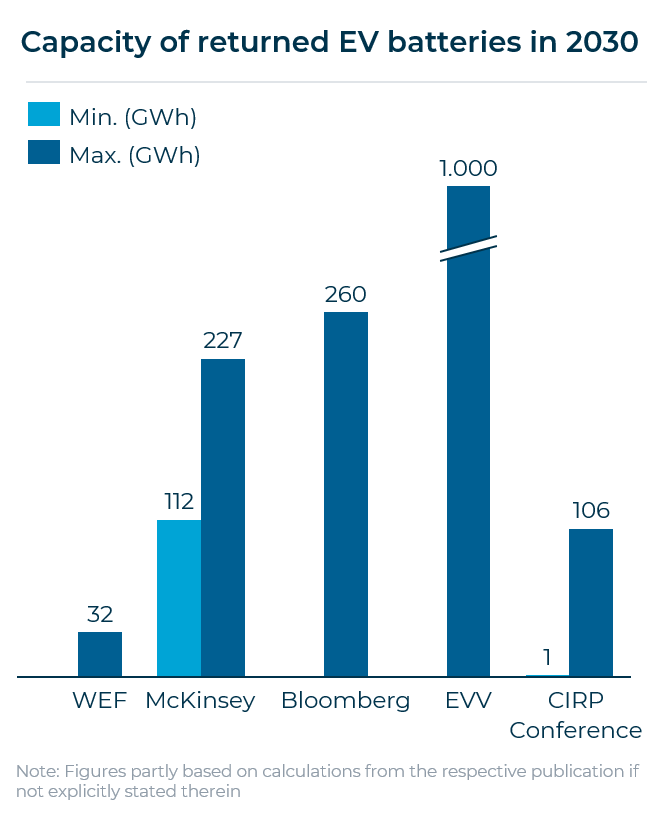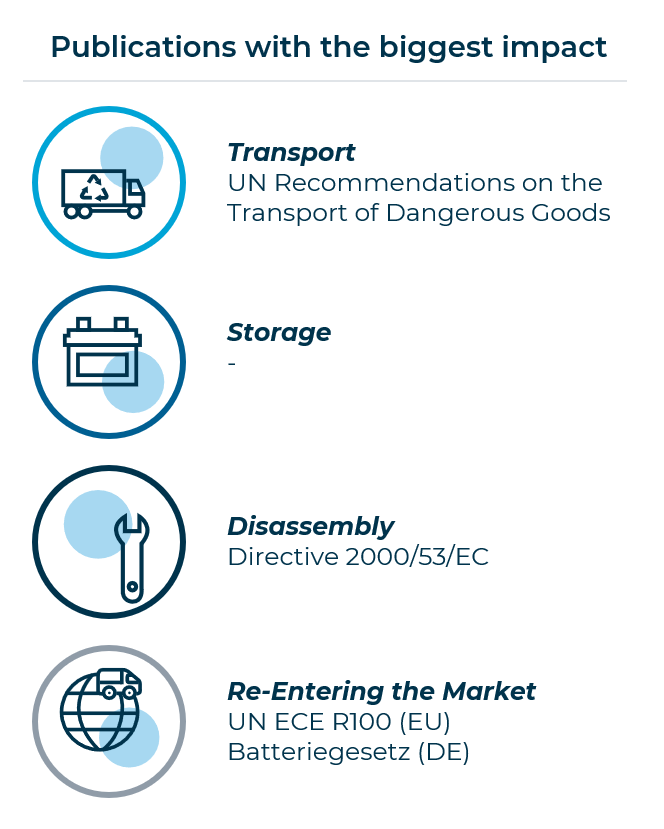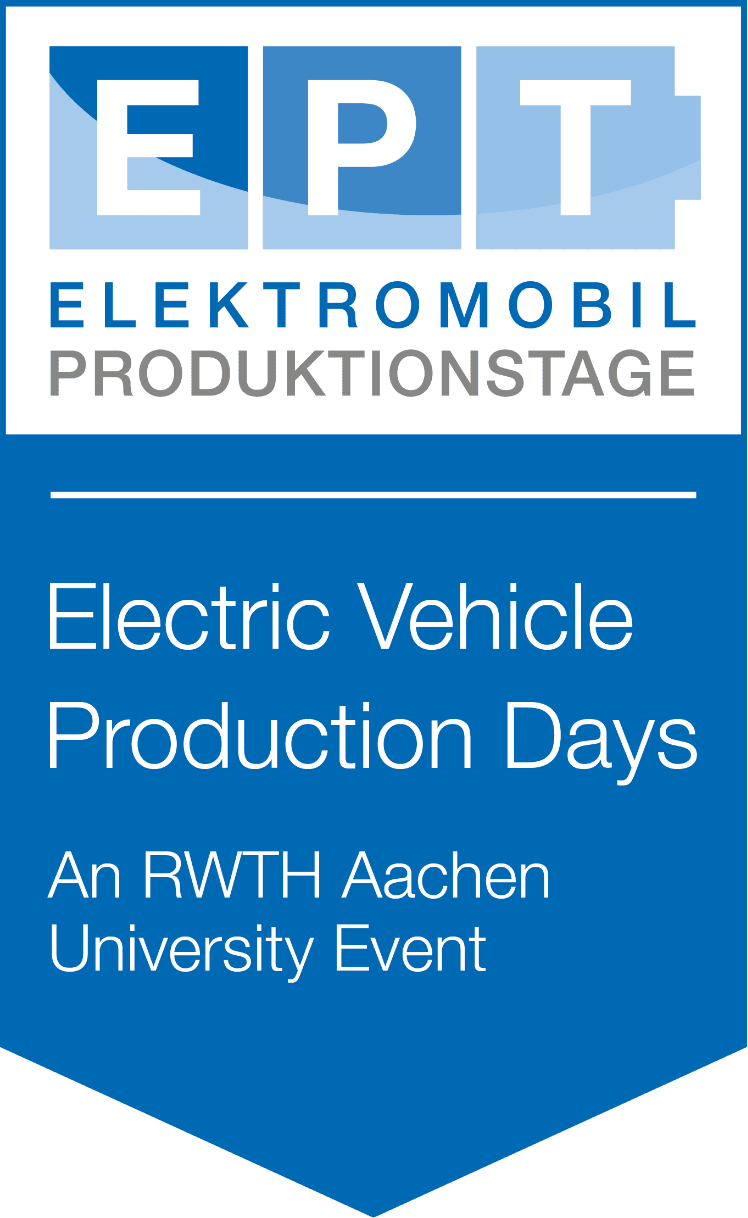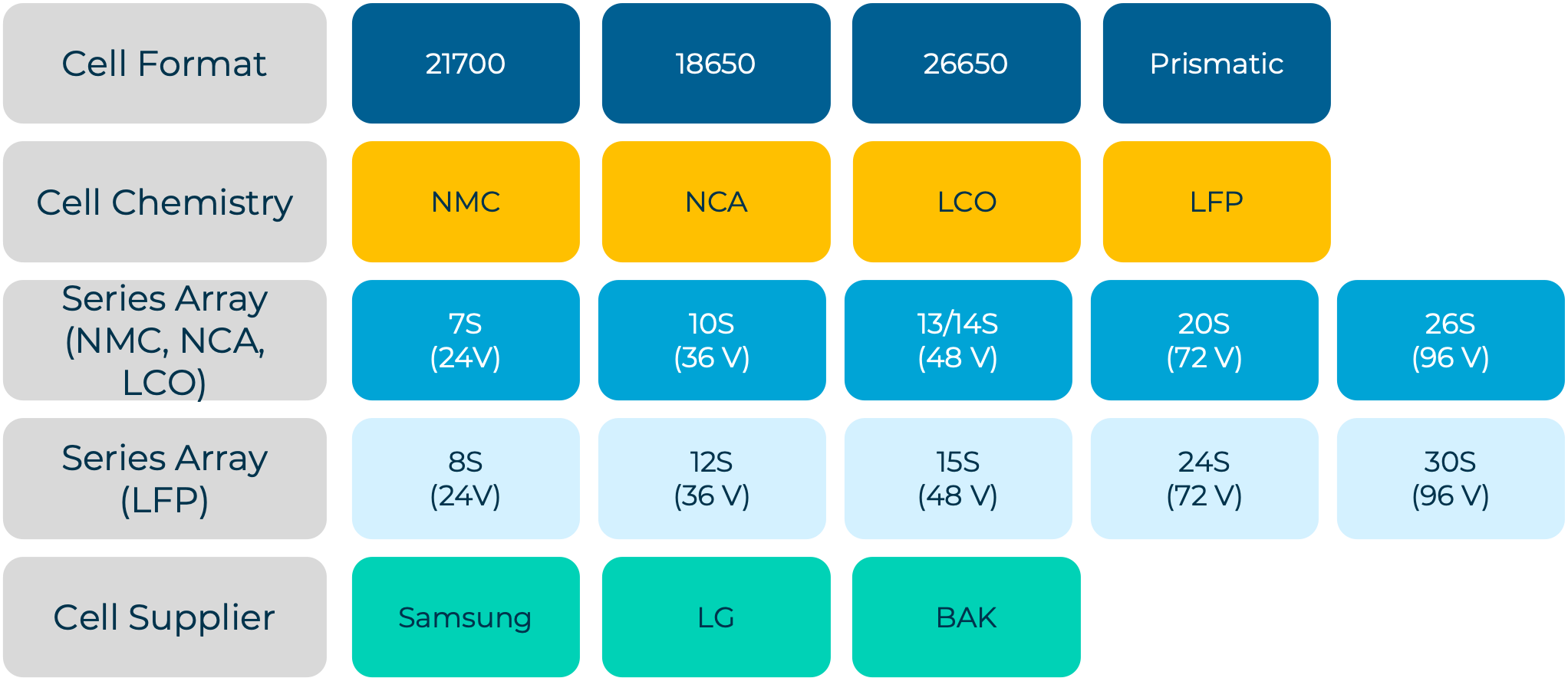EV Battery: Yesterday’s scrap is tomorrow’s gold
Used vehicle batteries are a valuable resource and offer great business potential
Admittedly, it was a somewhat bumpy start. But now the topic of electromobility seems to have gained full momentum. [1] In its “Electromobility Report 2020” [2], the “Center of Automotive Management (CAM)” predicts growth in e-vehicle registrations in Germany. According to the scientific institute for empirical automotive and mobility research at the University of Applied Sciences in Bergisch Gladbach, the share of e-vehicles will already rise to 27 percent of new sales by 2025 – of which around 65 percent are likely to be pure electric vehicles, as distinguished from hybrid models.

But what are the implications of the boom in electromobility? In addition to the obvious growth in vehicles with renewable drives, another billion-dollar market is already developing. According to studies, a segment for “2nd life” batteries of up to 1,000 gigawatt hours is expected by 2030.
Despite the euphoria that such inspiring figures can quickly generate, some challenges remain. Improved standardization and design of EV batteries – especially for their planned “second life” – as well as networking of market players and industries are needed to really take advantage of the market. The same applies to the consideration of whether reuse or recycling is more effective for different use cases.
Against this background, the aspects of “remanufacturing” and “2nd life” are not only an exciting topic for the future, but also one of the decisive success criteria for a successful mobility turnaround.
In our recently completed consortium study, together with the Chair of Production Engineering of E-Mobility Components (PEM) and the Chair of Process Metallurgy and Metal Recycling (IME) and eight partners along the battery value chain – from vehicle and battery manufacturers to plant manufacturers and suppliers to start-up companies in the “2nd Life” sector – we identified ways and opportunities to get more out of used EV batteries in the future. In doing so, the project team analyzed new approaches and well-known challenges.
„Getting electromobility into the market was our first challenge – and today its business potential is becoming apparent. In the same way, we now need to develop the potential of the ‘2nd life’ market for batteries. It’s about implementing innovations and shaping the future.“
Dr. Christoph Deutskens, CEO PEM Motion GmbH
The status quo: where do we start?
Today’s batteries and battery systems are only designed for the first phase of their service life. This means: until recently, there was no incentive to think about later reuse or recycling during development or production. The state of knowledge on the assessment of used batteries with regard to their aging process and their “State of Health” (SoH) was therefore largely unknown. This is only gradually changing with the emergence of companies and projects dedicated to the subject. Meanwhile, the experience gained from the consortium study has demonstrated the potential of some methods and has prompted further research projects to evaluate and disseminate the latest technologies.
While the current focus is on achieving the highest possible market penetration with e-vehicles, we are already looking one step further: at the processes that follow, because so far there is no predominant battery concept that focuses on sustainability and secondary use in both the product and the process.
In summary, there are three key segments for efficient battery reuse:
- Legal foundations in the form of norms and standards should address “remanufacturing” and “2nd life”. This is the only way to define a uniform direction for all companies involved in the value chain. The EU Commission, meanwhile, is planning stricter target values for recycling efficiency and reuse of used batteries with the revision of Directive 2006/66/EC on battery recycling. The study has highlighted the issues that the consortium partners can work on to prepare for the new environment.
- Improving recycling efficiency may not be enough. The selection of materials used in the battery system is also an important aspect.
- A coherent infrastructure concept should be launched today to adequately deal with the huge return of batteries and to achieve a high return rate.
„The sooner and better we answer the questions about the reuse and recycling of batteries, the more environmentally friendly e-mobility will become and the higher its social acceptance will be. We need a circular economy. Already today, we are technically capable of recovering up to 95 percent of the important materials.“
Prof. Achim Kampker, Head of the Chair „Production Engineering of E-Mobility Components“ (PEM) at RWTH Aachen University
Norms and standards: Questions about questions
One of the major challenges for a “2nd Life”: So far, there are no uniform strategies in the field of norms and standards for battery recycling and reuse: In most documents, there are either no explicit or only passing mentions of this. Many questions remain fundamentally unanswered. For example: At what point is a battery no longer a “new” battery? Under what conditions should it be considered waste or a commodity for repurposing? How can the value of a used battery be determined for repurposing? What kind of disassembly information should be provided? How should the dismantling process be designed? What are the specific procedural rules for storing used batteries? Should recycling and reuse regulations differ?
For this reason, a complete work package in our consortium study was dedicated to the challenges in the field of battery reuse standards. The seemingly simple result: existing regulations and standards should be consolidated and revised. Future publications could fill the existing gap. An example is provided by the Standards for Battery Secondary Use (SAE J2997), in which work is underway to develop standards for a testing and evaluation scheme to prepare batteries for flexible and safe reuse. This will draw on existing or in-progress standards such as transportation, labeling, and health condition standards. SAE J2997 is committed to supplementing these reference standards with the necessary information to ensure safe and reliable use, even in “2nd Life”.

Every battery is different: the basics of aging
Battery aging is a highly complex issue, because the individual cells and modules within a battery pack generally age at different rates. Since the total capacity depends on the weakest cells, it is often the case that a battery is no longer suitable for use in a vehicle – i.e. its capacity is below around 80 percent SoH – even though there are definitely still some functional cells and modules in the pack.
In our study, we therefore examined five batteries from different vehicle manufacturers and from different lifecycle phases. We found that the residual value of a battery – in contrast to the classic combustion engine – cannot be determined by driving performance alone. In our aging checks, we looked at what effects driving performance and the type of application have on the SoH.

The key finding after the tests was: unlike the classic internal combustion engine, which loses value the more mileage it has done and the longer the engine has been in operation, the aging and value determination of batteries is different after the first life cycle. The parameters of each specific battery evolve differently during aging. Other parameters, such as the so-called State of Charge (SoC) and temperature, have a greater influence than basic aging. In particular, the resistance increases gradually while the time constant increases sharply as the cells age. The difference in these values between 50 percent and high or low SoC also evolves with aging. These characteristics can be determined by pulse testing to determine the suitability of a used battery for repurposing. During the course of the study, it was demonstrated that onboard diagnostic signals can be used to collect data from such pulse tests without disassembling the battery.
Efficient disassembly solutions
There is also a lot to consider when it comes to disassembly. During the study, numerous batteries from different manufacturers and with different characteristics were disassembled. The critical aspects of disassembly were identified and documented depending on the manufacturer. In this way, we derived product structures to formulate optimizations for future dismantling processes. All dismantled individual parts were analyzed and categorized with a view to possible reprocessing.
For the products of all manufacturers, we came to the conclusion that reassembly is possible, but that a standardized concept for simple disassembly and reassembly is not yet apparent. Together with our partners, we developed a model that can be used to calculate scenarios and processes for disassembly based on current sales figures. Since it is not yet possible to predict how high the sales figures will ultimately be and how long the batteries will actually last, a modular plant layout was important to us. This way, as the number of units increases, the capacity can be easily scaled accordingly. With this proposal, unit costs remain relatively constant once a relatively low production number is reached. If the assumptions are confirmed by practical implementation, this type of automation can also be profitable for the recycling industry.
More information on our modular and scalable planning approach can be found at https://pem-motion.com/success-guide/.
Conclusion
The “re-use”/recycling market for used EV batteries offers a volume in billions in the coming years. Nevertheless, there are currently hardly any standards and norms to take into account the step of disassembly and “re-use” already during the manufacturing of the batteries. Together with our partners, we have developed some strategies and processes for efficient remanufacturing based on market forecasts, competitive analyses and existing standards and norms.
The following main tasks resulted from our investigation:
- Currently, there is a lot of uncertainty regarding regulatory requirements for “2nd use”: Used batteries have to fulfill regulatory requirements of new products to a certain extent. There are hardly any references to remanufacturing and recycling standards in existing standards. This in turn means that, in theory, each stationary storage unit would have to be certified individually – which would make a cost-effective design unthinkable. One approach to revising the norms and standards is SAE J2997.
- In contrast to the classic combustion engine, the residual value of a battery does not result from mileage and age alone. It is precisely the usage history and the calendar age that have a major influence on the “state of health” of the discarded batteries.
- For price negotiations on used batteries, more efficient testing possibilities would have to be created in the future, as well as further history data collected. Such data could be used to simplify pricing in the future.
- Today’s battery packs are not designed for remanufacturing. For efficient disassembly and reassembly, this second path of use would have to be considered already in manufacturing or development – for example, when assembling the various parts.
PEM Motion and the chair “Production Engineering of E-Mobility Components” (PEM) at RWTH Aachen University are always open for further studies, solutions and projects. Is your company ready for a sustainable electrified future? Feel free to contact us to discuss ideas, challenges or projects.




